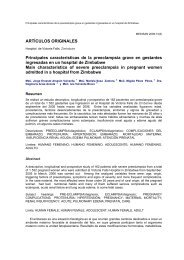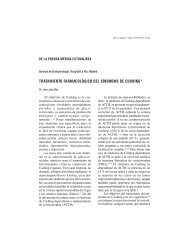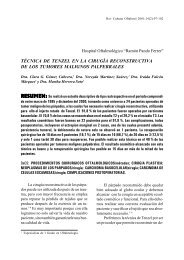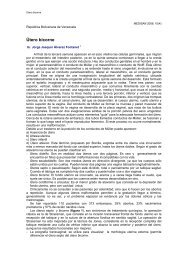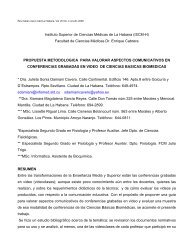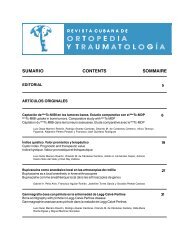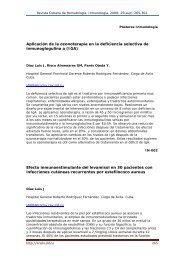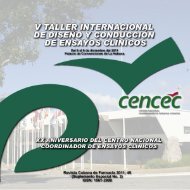Continuous heart murmur: a sign of inestimable value - Infomed
Continuous heart murmur: a sign of inestimable value - Infomed
Continuous heart murmur: a sign of inestimable value - Infomed
You also want an ePaper? Increase the reach of your titles
YUMPU automatically turns print PDFs into web optimized ePapers that Google loves.
Cuban Society <strong>of</strong> Cardiology<br />
________________________<br />
Review Article<br />
CorSalud 2013 Jul-Sep;5(3):285-295<br />
<strong>Continuous</strong> <strong>heart</strong> <strong>murmur</strong>: a <strong>sign</strong> <strong>of</strong> <strong>inestimable</strong> <strong>value</strong><br />
Dr. Hiram Tápanes Daumy a , MD; Maylín Peña Fernández b , MD; and Andrés Savío<br />
Benavides a , MD<br />
a William Soler Pediatric Cardiology Hospital. Havana, Cuba.<br />
b Carlos J. Finlay Military Hospital. Havana, Cuba.<br />
Este artículo también está disponible en español<br />
ARTICLE INFORMATION<br />
Received: 3 de diciembre de 2012<br />
Accepted: 21 de febrero de 2013<br />
Competing interests<br />
The authors declare no competing<br />
interests<br />
Acronyms<br />
APW: aortopulmonary window<br />
PDA: patent ductus arteriosus<br />
On-Line Versions:<br />
Spanish - English<br />
ABSTRACT<br />
This literature review is conducted to clarify the pathophysiological, semiological and<br />
causal elements <strong>of</strong> a continuous <strong>murmur</strong>, and describes the fundamental clinical<br />
elements <strong>of</strong> the different diseases that can cause these <strong>murmur</strong>s, and the criteria for<br />
its clinical, hemodynamic or surgical approaches. The semiological elements <strong>of</strong> a continuous<br />
<strong>murmur</strong> are emphasized, which complemented with electrocardiogram and<br />
telecardiogram allow us to reach a definite diagnosis with high accuracy, demonstrating<br />
that this is a <strong>sign</strong> <strong>of</strong> <strong>inestimable</strong> <strong>value</strong> to pediatric cardiologists.<br />
Palabras clave: Heart <strong>murmur</strong>, Congenital <strong>heart</strong> disease, Cardiology, Pediatrics<br />
Soplo continuo: un <strong>sign</strong>o de <strong>inestimable</strong> valor<br />
RESUMEN<br />
Con el objetivo de precisar los elementos fisiopatológicos, semiológicos y causales de<br />
un soplo continuo se realiza esta revisión bibliográfica, donde se describen los elementos<br />
clínicos fundamentales de las diferentes enfermedades capaces de provocar<br />
estos soplos, así como los criterios para su abordaje clínico, hemodinámico o quirúrgico.<br />
Se enfatiza en los elementos semiológicos de un soplo continuo, que complementados<br />
con el electrocardiograma y el telecardiograma nos permiten acercarnos<br />
con alta precisión al diagnóstico de certeza, lo que demuestra que este constituye un<br />
<strong>sign</strong>o de <strong>inestimable</strong> valor para el cardiopediatra.<br />
Palabras clave: Soplo, Cardiopatía congénita, Cardiología, Pediatría<br />
H Tápanes Daumy<br />
Cardiocentro Pediátrico William Soler<br />
Ave 43 Nº 1418. Esquina Calle 18.<br />
CP 11900. La Habana, Cuba<br />
E-mail address:<br />
hiramtapanes@infomed.sld.cu<br />
INTRODUCTION<br />
Heart <strong>murmur</strong>s are commonly detected during routine physical examination<br />
in the pediatric population and are the most prevalent <strong>sign</strong> <strong>of</strong> cardiopediatrics<br />
1-3 . Therefore, it is the leading cause <strong>of</strong> referral to pediatric cardiologists<br />
at Boston Children's Hospital 4 .<br />
The blood flow through the cardiovascular system is silent because the current<br />
is laminar as blood columns. Heart <strong>murmur</strong>s are the result <strong>of</strong> turbulence<br />
RNPS 2235-145 © 2009-2013 Cardiocentro Ernesto Che Guevara, Villa Clara, Cuba. All rights reserved. 285
<strong>Continuous</strong> <strong>heart</strong> <strong>murmur</strong>: a <strong>sign</strong> <strong>of</strong> <strong>inestimable</strong> <strong>value</strong><br />
in the current flowing at high speed into or out <strong>of</strong> the<br />
<strong>heart</strong>, causing audible vibrations that reach frequencies<br />
between 20 and 20 thousand hertz 5,6 .<br />
Three key factors determine the production <strong>of</strong> turbulence<br />
(<strong>murmur</strong>s), they are:<br />
1. Increasing flow through normal or abnormal valves<br />
in anterograde direction (normal direction).<br />
2. Forward flow through an irregular stenotic valve, or<br />
towards a dilated vessel (normal direction).<br />
3. Backward flow through an insufficient valve or<br />
congenital defect 5 .<br />
In general and considering the moment <strong>of</strong> the cardiac<br />
cycle in which <strong>murmur</strong>s appear, these can be<br />
classified into:<br />
• Systolic <strong>murmur</strong>s: They are divided into mesosystolic-ejective<br />
(aortic and pulmonary foci), and regurgitant<br />
that are auscultated at the level <strong>of</strong> the mitral<br />
and tricuspid atrioventricular valves; also those related<br />
to interventricular septation defects belong<br />
to this subgroup.<br />
• Diastolic <strong>murmur</strong>s: They are subdivided in regurgitant<br />
that are present in pulmonary and valvular<br />
aortic insufficiency cases, and those that relate to<br />
the rapid ventricular filling (mid-diastolic <strong>murmur</strong>s)<br />
and presystolic atrial filling.<br />
• <strong>Continuous</strong> <strong>murmur</strong>: those auscultated in both<br />
phases <strong>of</strong> the cardiac cycle and whose origin is represented<br />
by a long list <strong>of</strong> multiple causes.<br />
In this general classification <strong>of</strong> <strong>heart</strong> <strong>murmur</strong>s some<br />
authors include:<br />
• Systolic-diastolic <strong>murmur</strong>s: They can also be auscultated<br />
in both phases <strong>of</strong> the cardiac cycle but the<br />
second <strong>heart</strong> sound between them is defined,<br />
while in the continuous the second noise is masked<br />
by the <strong>murmur</strong>. The origin <strong>of</strong> systolic-dialostic <strong>murmur</strong>s<br />
is derived from the overlapping <strong>of</strong> diseases<br />
such as ventricular septal defect with aortic insufficiency,<br />
pulmonary or double aortic injury, common<br />
trunk with valvular insufficiency, among others 7 .<br />
• Innocent <strong>murmur</strong>s: They have a frequency <strong>of</strong> 60-<br />
85% in children between three and six years old,<br />
and are characterized by their short duration, systolic<br />
phase onset, low intensity, low irradiation,<br />
intensity change with the position and enhancement<br />
with hyperdynamic circulatory changes. In<br />
these cases, telecardiogram and electrocardiogram<br />
are normal. Among the most common causes are<br />
Fogel’s pulmonary <strong>murmur</strong>, aortic innocent <strong>murmur</strong>,<br />
Still’s vibratory <strong>murmur</strong> and Evans’ late <strong>murmur</strong><br />
8-11 .<br />
Other authors include these functional or innocent<br />
<strong>murmur</strong>s in the systolic group, having in mind that indeed<br />
all these occupy the systolic phase <strong>of</strong> the cardiac<br />
cycle.<br />
In order to clarify the pathophysiological, causal<br />
and semiological aspects <strong>of</strong> a continuous <strong>murmur</strong><br />
this literature review is conducted, which describes<br />
the fundamental clinical elements <strong>of</strong> the different<br />
diseases that can cause continuous <strong>murmur</strong>s, as well<br />
as the criteria for clinical, hemodynamic or surgical<br />
approaches.<br />
CAUSES FOR CONTINUOUS MURMUR<br />
<strong>Continuous</strong> <strong>murmur</strong>s are those that persist and are<br />
heard in systole and diastole, and are caused by the<br />
continuous flow <strong>of</strong> blood from an area <strong>of</strong> high pressure<br />
to one <strong>of</strong> low pressure, maintaining a pressure<br />
gradient throughout the cardiac cycle 8 .<br />
An essential element in the pathophysiology <strong>of</strong><br />
continuous <strong>murmur</strong> is the hemodynamic phenomenon<br />
responsible for maintaining a pressure gradient<br />
between the vessels, and capable <strong>of</strong> maintaining a<br />
turbulent flow which covers the systole and a segment<br />
<strong>of</strong> cardiac diastole, and masks the second cardiac<br />
sound.<br />
Some authors classify continuous <strong>murmur</strong>s according<br />
to the structures involved in the shunt and divide<br />
them into: arterio-arterial, arterio-venous and venovenous<br />
12 .<br />
The classical semiological description <strong>of</strong> a continuous<br />
<strong>murmur</strong> was made by Gibson in 1900 in relation<br />
to the <strong>murmur</strong> present in patent ductus arteriosus<br />
(PDA), referring to this as a machinery <strong>murmur</strong>. However,<br />
the diseases that make the causal list <strong>of</strong> the<br />
continuous <strong>murmur</strong> are multiple and all <strong>of</strong> them are<br />
especially relevant for the pediatric cardiologist.<br />
In general, the causes <strong>of</strong> continuous <strong>murmur</strong> are:<br />
1. PDA.<br />
2. Aortopulmonary window (APW).<br />
3. Ruptured aneurysm <strong>of</strong> sinus <strong>of</strong> Valsalva.<br />
4. Classic or modified Blalock - Taussig shunt.<br />
5. Coronary arteriovenous fistulas.<br />
6. Truncus arteriosus.<br />
286<br />
CorSalud 2013 Jul-Sep;5(3):285-295
Tápanes Daumy H, et al.<br />
7. Venous hum.<br />
8. Mammary souffle.<br />
All causes <strong>of</strong> continuous <strong>murmur</strong> except for the<br />
mammary souffle, appear in childhood, and are<br />
associated with congenital malformations or palliative<br />
procedures related to these.<br />
Patent ductus arteriosus<br />
As the name suggests it is caused by postnatal persistence<br />
<strong>of</strong> the ductus arteriosus, which is an embryological<br />
structure originating from the distal left sixth<br />
aortic arch and connects the pulmonary artery trunk,<br />
near the left pulmonary artery branch, with the descending<br />
thoracic aorta <strong>of</strong> the left subclavian artery<br />
after birth. The existence <strong>of</strong> the ductus arteriosus is<br />
essential for intrauterine life, as 60% <strong>of</strong> the cardiac<br />
output passes through it.<br />
The first accurate description <strong>of</strong> the ductus arteriosus<br />
was made by James Gibson in 1900, however,<br />
William Harvey had already made excellent anatomical<br />
descriptions in the sixteenth century 7,12 .<br />
For its size and hemodynamic effects PDA is classified<br />
as:<br />
- Large: when it measures over six millimeters at<br />
both ends (aortic and pulmonary).<br />
- Moderate: when it measures three to six millimeters<br />
at both ends (aortic and pulmonary).<br />
- Small: when measures less than three millimeters<br />
at both ends.<br />
According to the angiographic morphology <strong>of</strong> the<br />
duct, Krishenko 7 (1989) classified them into:<br />
- Type A: cylindrical, flattened, and semi-closed towards<br />
the pulmonary end.<br />
- Type B: cylindrical, flattened, and semi-closed towards<br />
the aortic end.<br />
- Type C: cylindrical, straight without recesses.<br />
- Type D: cylindrical, with lung and aortic double recess.<br />
- Type E: Long with recess close to the lung one.<br />
Its clinic is booming from the third month <strong>of</strong> life,<br />
when pulmonary pressures fall, and is mainly characterized<br />
by tachypnea, repeated broncho-catarrhal episodes,<br />
celer-type bulging arterial pulses, continuous<br />
<strong>murmur</strong> in I-II left intercostal space, rumbling and left<br />
gallop rhythm.<br />
Follow up <strong>of</strong> continuous <strong>murmur</strong> in this disease is<br />
extremely important for the pediatric cardiologist<br />
since its absence, or the only presence <strong>of</strong> the diastolic<br />
component, together with a pulmonary component <strong>of</strong><br />
the second hyperphonetic sound should lead to suspect<br />
the presence <strong>of</strong> pulmonary hypertension, which<br />
in extreme circumstances leads to the Eisenmenger<br />
syndrome, that determines the impossibility <strong>of</strong> the<br />
definitive defect correction.<br />
Diagnosis is complemented by the electrocardiogram<br />
that can vary over a spectrum that goes from<br />
normal in small PDA to biventricular growth in that <strong>of</strong><br />
large hemodynamics impact. When Eisenmenger syndrome<br />
develops some <strong>sign</strong>s <strong>of</strong> right ventricular hypertrophy<br />
appear with QRS axis to the right, tall R in V1<br />
and V2 and right Sokol<strong>of</strong>f-Lyon <strong>sign</strong>s (R <strong>of</strong> V 1 -V 2 + S <strong>of</strong><br />
V 5 -V 6 greater than 11 millimeters).<br />
In telecardiogram some <strong>sign</strong>s <strong>of</strong> left ventricular hypertrophy<br />
with a domed pulmonary artery trunk and<br />
increased pulmonary flow are observed, although in<br />
small PDA the telecardiogram can approximate the<br />
normal. In Eisenmenger syndrome pulmonary oligohemia<br />
is associated with right ventricular growth.<br />
Echocardiography confirms the diagnosis.<br />
Medical treatment is focused on the control <strong>of</strong><br />
<strong>heart</strong> failure with diuretics, aldosterone inhibitors, digoxin,<br />
angiotensin converting enzyme inhibitors or angiotensin<br />
II–receptor inhibitors.<br />
Its definitive treatment, depending on the protocols<br />
that the different institutions use, may be catheterization<br />
(percutaneous coronary intervention) or<br />
surgery, which is usually simple and free <strong>of</strong> morbidity<br />
and mortality, with rare exceptions.<br />
Aortopulmonary window<br />
It is a direct communication between the ascending<br />
aorta and the pulmonary artery trunk, resulting from a<br />
partial failure in the development <strong>of</strong> aortic-pulmonary<br />
septal complex, a structure that in its embryological<br />
origin divides the great vessels 14,15 .<br />
One might state that APW is a defect that occupies<br />
an intermediate position between normality and truncus<br />
arteriosus (total deficit in the formation <strong>of</strong> aorticpulmonary<br />
septal complex), from which it differs since<br />
in APW there are two semilunar valves: the aortic and<br />
pulmonary valves, whereas in the truncus arteriosus<br />
there is only one sigmoid or trunk valve and a single<br />
vessel leaving the <strong>heart</strong>, from which, depending on the<br />
CorSalud 2013 Jul-Sep;5(3):285-295 287
<strong>Continuous</strong> <strong>heart</strong> <strong>murmur</strong>: a <strong>sign</strong> <strong>of</strong> <strong>inestimable</strong> <strong>value</strong><br />
anatomical variant, the pulmonary branches and<br />
supra-aortic trunks are born in a different position.<br />
This congenital <strong>heart</strong> disease was first described in<br />
1830 by Elliotson in an anatomical specimen, while<br />
Cooley performed the first successful corrective surgery<br />
in 1957 16 .<br />
APW is a really rare malformation with an estimated<br />
incidence <strong>of</strong> 0.2 to 0.6% <strong>of</strong> all congenital <strong>heart</strong><br />
diseases 17 . There are various classifications and the<br />
most accepted is that <strong>of</strong> Mori et al 18 , which divide<br />
them into:<br />
- Type I or proximal: the defect is circular in a equidistant<br />
area between the sigmoid valve and the<br />
bifurcation <strong>of</strong> the pulmonary branches. It constitutes<br />
70% <strong>of</strong> cases.<br />
- Type II or distal: It has spiral shape and affects the<br />
trunk and the origin <strong>of</strong> the right pulmonary artery.<br />
It constitutes 25% <strong>of</strong> cases.<br />
- Type III: Complete aortopulmonary septum defect.<br />
It represents the remaining 5%.<br />
Its symptoms appear around the first month <strong>of</strong> life<br />
and are characterized by dyspnea (occurring with<br />
feedings), sweating, growth retardation and respiratory<br />
distress.<br />
On physical examination tachycardia and tachypnea<br />
are predominant. The <strong>sign</strong>s found on auscultation<br />
are very similar to those <strong>of</strong> PDA with continuous<br />
<strong>murmur</strong>, mitral rumble and left gallop, but unlike PDA<br />
there are early <strong>sign</strong>s <strong>of</strong> irreversible pulmonary hypertension.<br />
This situation requires surgical correction<br />
before 6 months <strong>of</strong> age 15,19 , although there have been<br />
closures, in specific circumstances, by interventional<br />
catheterization 14,20 .<br />
Ruptured aneurysm <strong>of</strong> sinus <strong>of</strong> Valsalva<br />
The sinuses <strong>of</strong> Valsalva are aortic wall dilations located<br />
between the aortic annulus and the sinotubular junction.<br />
Its location is related to the coronary arteries;<br />
therefore they are de<strong>sign</strong>ated as right or left coronary<br />
sinus, and non-coronary sinus 21-23 . Aneurysm <strong>of</strong> Sinus<br />
<strong>of</strong> Valsalva is defined as the dilation <strong>of</strong> one <strong>of</strong> them<br />
with loss <strong>of</strong> continuity between the middle layer <strong>of</strong> the<br />
aortic wall and the valve annulus 21,23,24 .<br />
The incidence <strong>of</strong> this <strong>heart</strong> disease is estimated<br />
between 0.15 and 1.5%. Some authors suggest that<br />
there is an ethnic variability in the presentation <strong>of</strong> this<br />
type <strong>of</strong> disease; hence it is known that it is five times<br />
more common in Asians than in Western countries,<br />
and is presented with a male to female ratio <strong>of</strong> 4:1 25 .<br />
The cause <strong>of</strong> the aneurysm can be congenital or<br />
acquired, in turn, acquired forms can be traumatic, infectious<br />
(primarily syphilitic aortitis) or due to degenerative<br />
diseases 22,23 . Right sinus aneurysmal rupture<br />
is much more frequent (65 to 86% <strong>of</strong> cases), followed<br />
by the non-coronary (between 10 and 30%) and finally,<br />
left sinus rupture with 2 and 5% cases.<br />
Aneurysm rupture towards the cardiac chambers<br />
occurs approximately in the following order <strong>of</strong> frequency,<br />
right ventricle (60%), right atrium (29%), left<br />
atrium (6%) and left ventricle (4%).<br />
Extracardiac ruptures in the pericardium or pleura<br />
are extremely rare, but fatal, usually due to aneurysms<br />
<strong>of</strong> acquired origin 21,22,24-26 .<br />
The pathophysiology <strong>of</strong> this condition depends primarily<br />
on the volume circulating through the communication,<br />
on the rapidity with which it sets, on the<br />
cardiac chamber with which the exchange is established<br />
and the functionality <strong>of</strong> such chamber. Therefore,<br />
a variety <strong>of</strong> symptoms and <strong>sign</strong>s can be present:<br />
cough, fatigue, chest pain, dyspnea, arrhythmias, and<br />
coronary artery compression with <strong>sign</strong>s <strong>of</strong> ischemia,<br />
with an always present continuous <strong>murmur</strong>. However,<br />
when perforation is gradual this can acceptably be<br />
tolerated in 25% <strong>of</strong> cases 22,26 .<br />
The only formal classification for ruptured aneurysm<br />
<strong>of</strong> sinus <strong>of</strong> Valsalva was made by Sakakibara and<br />
Konno in 1962 (Table 1). Taking into account the<br />
affected coronary sinus and the area to which it bulges<br />
or breaks, four types are identified 21-23,27,28 .<br />
Type<br />
I<br />
II<br />
IIIa<br />
IIIv<br />
IIIa+v<br />
IV<br />
Tabla 1. Clasificación de Sakakibara y Konno de los<br />
aneurismas del seno de Valsalva 27,28 .<br />
Connection<br />
Right SV with the outflow tract <strong>of</strong> the right<br />
ventricle below the pulmonary valve<br />
Right SV with right ventricle in the<br />
supraventricular crest<br />
Right SV with the right atrium<br />
Posterior area <strong>of</strong> right SV with the right ventricle<br />
Right SV with atrium and the right ventricle<br />
Non-coronary SV with right atrium<br />
SV= Sinus <strong>of</strong> Valsalva<br />
288<br />
CorSalud 2013 Jul-Sep;5(3):285-295
Tápanes Daumy H, et al.<br />
About 20% <strong>of</strong> congenital aneurysms <strong>of</strong> the sinus <strong>of</strong><br />
Valsalva are not perforated and they are discovered at<br />
autopsy or at surgery for a coexisting ventricular septal<br />
defect. When a ruptured or intact aneurysm <strong>of</strong> Valsalva<br />
penetrates the interventricular septum base it<br />
can cause a complete <strong>heart</strong> block which can cause<br />
death or syncope 29 .<br />
This disorder is <strong>of</strong>ten linked to other congenital<br />
defects, primarily with interventricular communication,<br />
most <strong>of</strong>ten in type I or supracrestal 30 it may also<br />
be associated with aortic regurgitation (41.9%),<br />
pulmonary stenosis (9.7%) or aortic (6.5%), aortic coarctation<br />
(6.5%), PDA (3.2%) and tricuspid regurgitation<br />
(3.2%) 30,31 .<br />
Most patients without rupture remain asymptomatic.<br />
When rupture occurs, usually between the second<br />
and third decades <strong>of</strong> life, the clinical presentation is<br />
usually acute chest pain or <strong>heart</strong> failure data. If the<br />
shunt magnitude is not <strong>sign</strong>ificant, these patients can<br />
be stabilized for a few days, however, they develop<br />
progressive aortic insufficiency and their survival without<br />
surgery is limited, with an average <strong>of</strong> 3.9 years 32 .<br />
The electrocardiogram may vary between normality<br />
and the presence <strong>of</strong> QRS axis to the right and<br />
tall R in V1, with the corresponding ST and T depression<br />
due to right ventricular volume overload;<br />
<strong>sign</strong>s <strong>of</strong> myocardial ischemia are much rarer. The telecardiogram<br />
may show a mild cardiomegaly by hypertrophy<br />
and dilation <strong>of</strong> the right cavities and increased<br />
pulmonary flow, with a bulged pulmonary artery<br />
trunk. All this will depend on the degree <strong>of</strong> hemodynamic<br />
impact <strong>of</strong> the <strong>heart</strong> disease 30-32 .<br />
Echocardiography has a diagnostic accuracy<br />
between 75 and 90% in both ruptured and intact<br />
aneurysms. With this method we can discriminate the<br />
size, sinus <strong>of</strong> origin, termination or drainage site,<br />
severity, valvular regurgitation mechanism, cardiac or<br />
vascular abnormalities associated, which are very<br />
important data for surgery 21,26,27 . The angiographic<br />
study, considered the baseline examination, is rarely<br />
necessary for diagnosis. CT scan and MRI <strong>of</strong>fer high<br />
sensitivity and specificity, but their use for the diagnosis<br />
<strong>of</strong> this type <strong>of</strong> condition is very limited 21,26,27,33-36 .<br />
Due to disease evolution all patients should be<br />
surgically treated 29,33 . The first intervention <strong>of</strong> this kind<br />
took place in 1955, under deep hypothermia without<br />
cardiopulmonar bypass 23 . Surgical treatment <strong>of</strong> aneurysm<br />
<strong>of</strong> the sinus <strong>of</strong> Valsalva is safe, with a mortality <strong>of</strong><br />
about 1% 21,27 . Some authors suggest that perioperative<br />
mortality increases 4-5 times in cases <strong>of</strong> infection or<br />
endocarditis 21,27 . Au et al. 37 conducted a review <strong>of</strong> 53<br />
patients operated on between 1978 and 1996, and<br />
reported satisfactory results with large long-term<br />
survival, absence <strong>of</strong> early perioperative deaths and<br />
recurrences after initial repair 29,37 .<br />
Blalock-Taussig Surgical Shunt<br />
This procedure is named after its creators, two American<br />
doctors, Helen Brooke Taussig, for many "Mother<br />
<strong>of</strong> cardiopediatrics" and the surgeon Alfred Blalock,<br />
who performed an extraordinary act on November 29,<br />
1944, when created a palliative communication<br />
between the subclavian artery and a pulmonary artery<br />
branch 38 . The joy <strong>of</strong> being the first to benefit from the<br />
procedure was for Eileen Saxon, and this milestone<br />
was multiplied by thousands and gave hope <strong>of</strong> life to<br />
countless patients. According to Jaramillo 39 , Potts and<br />
colleagues in 1946 described an anastomotic procedure<br />
between the descending aorta and left pulmonary<br />
artery branch, while Waterston in 1962, published<br />
a technique that consisted <strong>of</strong> anastomosing<br />
the ascending aorta to the right pulmonary artery and<br />
other techniques that emerged in time. The techniques<br />
<strong>of</strong> Potts and Waterston have practically fallen<br />
into disuse for causing excessive pulmonary flow, left<br />
<strong>heart</strong> failure, obstructive pulmonary hypertension, and<br />
distortion problems when making definitive intracardiac<br />
repair and due to an increase in mortality <strong>of</strong> up<br />
40% in relation to the Blalock-Taussig shunt 39,40 .<br />
This classic procedure was modified in 1980 according<br />
to a proposal made by McKay and colleagues, and<br />
a synthetic material such as the polytetrafluoroethylene<br />
type began to be used; grafts from 3-5 mm were<br />
used and a number <strong>of</strong> advantages with the modified<br />
procedure were recognized 39,41,42 :<br />
- High early patency.<br />
- Shunt regulation by systemic artery size.<br />
- Preservation <strong>of</strong> the subclavian artery for future definitive<br />
correction.<br />
- Relative ease <strong>of</strong> surgical procedure in relation to<br />
the classic one.<br />
- Easiness to interrupt the shunt when the complete<br />
repair is done.<br />
The disadvantages <strong>of</strong> the modified Blalock-Taussig<br />
procedure are 39,41,42 :<br />
- Polytetrafluoroethylene is not an optimal material,<br />
CorSalud 2013 Jul-Sep;5(3):285-295 289
<strong>Continuous</strong> <strong>heart</strong> <strong>murmur</strong>: a <strong>sign</strong> <strong>of</strong> <strong>inestimable</strong> <strong>value</strong><br />
prone to the formation <strong>of</strong> “pseudointima” and late<br />
obstruction, especially when they are from 3 to 3.5<br />
mm.<br />
- Distortion <strong>of</strong> the pulmonary artery anatomy by use<br />
<strong>of</strong> rigid and thick shunted material to small or thin<br />
branches.<br />
Despite created more than 65 years ago, the Blalock-Taussig<br />
shunt, with some modifications now, remains<br />
a palliative procedure, essential for patients<br />
with cyanotic congenital <strong>heart</strong> disease and pulmonary<br />
flow alteration and therefore <strong>of</strong> alveolar pulmonary<br />
hematosis.<br />
Truncus arteriosus<br />
The truncus arteriosus is a congenital <strong>heart</strong> disease<br />
characterized by a single arterial trunk coming from<br />
the <strong>heart</strong>, and gives rise to the coronary arteries, the<br />
pulmonary arteries (or at least one) and brachiocephalic<br />
arteries 43-45 .<br />
The unique truncus arteriosus usually originates<br />
from two distinct ventricles and is accompanied by a<br />
large ventricular septal defect with a single trunk and<br />
malformed valve. It is a rare <strong>heart</strong> disease. The prevalence<br />
is 0.03 per 1,000 live births and occupies 0.7<br />
to 1.4% <strong>of</strong> congenital <strong>heart</strong> defects 46,47 . In the embryology<br />
<strong>of</strong> this malformation a disorder in the septal<br />
aortic-pulmonary complex formation occurs, so the<br />
truncus arteriosus is maintained as a single structure<br />
from which the coronary arteries emerge, the pulmonary<br />
arteries and supraaortic trunks, so a mixture<br />
<strong>of</strong> arterial and venous blood is produced with consequent<br />
cyanosis and increased pulmonary flow, which<br />
can lead to pulmonary hypertension 48 .<br />
According to Somoza 48 , the first description <strong>of</strong> this<br />
<strong>heart</strong> disease is attributed to Wilson in 1798, and the<br />
important contributions <strong>of</strong> Buchanan and Preisz are<br />
highlighted.<br />
In the early twentieth century multiple classifications<br />
<strong>of</strong> this <strong>heart</strong> condition appeared, and those <strong>of</strong><br />
Collet and Edwards (1949) 49-51 and Van Praagh<br />
(1965) 50,51 are the most commonly used (Table 2).<br />
The typical clinical presentation is that <strong>of</strong> congestive<br />
<strong>heart</strong> failure that starts in the first weeks <strong>of</strong><br />
life. Parents report that the child tires easily with<br />
feedings, and presents tachypnea and pr<strong>of</strong>use diaphoresis,<br />
there is usually evident cyanosis at birth and<br />
this increases with age. On physical examination, we<br />
can have a first normal sound with loud opening crack<br />
and the second sound is unique. There may be high<br />
frequency diastolic pulmonary <strong>murmur</strong> due to trunk<br />
valve insufficiency. The continuous <strong>murmur</strong> in this<br />
condition is rare, due to the appearance <strong>of</strong> aortopulmonary<br />
collaterals or when ostial stenosis <strong>of</strong> the<br />
pulmonary branches is present.<br />
The electrocardiogram and X-ray show <strong>sign</strong>s <strong>of</strong><br />
right or biventricular growth, with increased pulmonary<br />
flow and ovoid morphology 48 . The echocardiogram<br />
shows the emergence <strong>of</strong> the trunk vessel overriding<br />
the interventricular septum, which serves as a<br />
ro<strong>of</strong>, also both pulmonary arteries originating from it<br />
can be seen, and the location <strong>of</strong> the aortic arch (right<br />
or left) can be determined 48 .<br />
The presence <strong>of</strong> this disease is a strict and absolute<br />
indication for surgery, which is usually performed at<br />
around 3 months <strong>of</strong> age, for as long as the patient's<br />
condition allows, pulmonary artery pressures are ex-<br />
Table 2. Collet and Edwards and Van Praagh classifications <strong>of</strong> truncus arteriosus.<br />
Collet and Edwards<br />
Van Praagh<br />
Type Description Type Description<br />
I<br />
There is a common pulmonary trunk from the<br />
It matches type I <strong>of</strong> Collet and<br />
A1<br />
truncal artery<br />
Edwards<br />
II<br />
Independent origin, but very close to the<br />
Includes types II and III <strong>of</strong> Collet<br />
A2<br />
pulmonary arteries<br />
and Edwards<br />
IIIa<br />
Independent and distant origin <strong>of</strong> both pulmonary<br />
Absence <strong>of</strong> pulmonary branch<br />
A3<br />
arteries<br />
(hemitrunk)<br />
IIIv<br />
Pulmonary branches emerging from the descending<br />
Truncus associated with<br />
aorta (for some it is considered an extreme form <strong>of</strong> A4<br />
interrupted aortic arch<br />
Fallot with pulmonary atresia)<br />
290<br />
CorSalud 2013 Jul-Sep;5(3):285-295
Tápanes Daumy H, et al.<br />
pected to drop. To ensure continuity <strong>of</strong> the pulmonary<br />
vasculature and the right ventricle, valve conduit with<br />
certain characteristics are used whose prognosis and<br />
durability depend primarily on: a) performing surgery<br />
at an earlier age, even during the first month <strong>of</strong> life, b)<br />
improvement <strong>of</strong> cardiopulmonary bypass techniques<br />
and myocardial protection in the neonate c) improvement<br />
in postoperative care <strong>of</strong> patients. For simple<br />
forms postoperative mortality is 5 to 10%, while in the<br />
complex forms it can reach 20% 51 .<br />
Coronary arteriovenous fistulas<br />
In the context <strong>of</strong> congenital anomalies <strong>of</strong> coronary arteries,<br />
fistulas are classified as termination anomalies<br />
and constitute between 0.2% and 0.4% <strong>of</strong> congenital<br />
<strong>heart</strong> disease 52 , despite its low incidence it is the most<br />
frequent <strong>of</strong> coronary anomalies, so it can be found in<br />
0.15% <strong>of</strong> coronary angiograms performed 53 . It is one <strong>of</strong><br />
the most common congenital malformations <strong>of</strong> coronary<br />
circulation allowing survival into adulthood 54,55 .<br />
The first description <strong>of</strong> these fistulas was published<br />
by Krause in 1865 and mentioned by Abbot 57 in 1906,<br />
and the first surgical correction was performed by<br />
Björk y Crafoord 58 in 1947.<br />
Regarding the fistulous structure site <strong>of</strong> origin, the<br />
right coronary artery constitutes 55% <strong>of</strong> cases, left<br />
coronary artery 35% and 5% for both. 90% <strong>of</strong> fistulas<br />
end on the right side <strong>of</strong> the <strong>heart</strong>, in order <strong>of</strong> frequency:<br />
in the right ventricle, right atrium, the coronary<br />
sinus and the pulmonary circulation, they rarely end<br />
in the left ventricle 52,59 .<br />
Patients with this disease may remain asymptomatic<br />
until adulthood. When symptoms occur, the most<br />
common are: angina pectoris by coronary stealing,<br />
dyspnea by pulmonary hypertension, manifestations<br />
<strong>of</strong> infective endocarditis or <strong>heart</strong> failure 59,60 . Anecdotally,<br />
hemoptysis has been found 61 .<br />
The most important findings on physical examination<br />
(when present) are the continuous <strong>murmur</strong> and<br />
<strong>sign</strong>s <strong>of</strong> <strong>heart</strong> failure, pulmonary hypertension or<br />
myocardial ischemia.<br />
Diagnosis is mostly supplemented by two-dimensional<br />
color Doppler echocardiography which gives us<br />
the essential data <strong>of</strong> the anatomy and pathophysiology<br />
<strong>of</strong> the lesion 62 . Cardiac catheterization is the<br />
study <strong>of</strong> choice to define the anatomy <strong>of</strong> the coronary<br />
anomaly and its hemodynamic effect and to define<br />
existing cardiac abnormalities or the presence <strong>of</strong> coronary<br />
obstruction. Other echocardiographic modalities<br />
are also useful, for example contrast CT scans and<br />
MRI 62,63 .<br />
Regarding final management opinions are divided,<br />
some authors recommend the closure <strong>of</strong> all fistulas in<br />
childhood, even if asymptomatic, others, however,<br />
propose that only symptomatic patients should be<br />
treated or those at risk <strong>of</strong> complications 64,65 . The percutaneous<br />
treatment is proposed today as the elective<br />
method, less radical and a shorter hospital stay 66 , and<br />
surgery is reserved for cases with multiple fistulas<br />
when the fistulous path is narrow and restrictive and<br />
drains into a cardiac chamber, or when complications<br />
arise during coils embolization 67-69 .<br />
Venous Hum<br />
According to Zarco 5 , it was described by Potain in 1867<br />
as a continuous innocent or benign <strong>murmur</strong> <strong>of</strong> lowfrequency<br />
sound that is auscultated in children, mainly<br />
between 3 and 6 years old. It is due to the passage <strong>of</strong><br />
blood at high speed through the veins <strong>of</strong> the neck, and<br />
is auscultated more <strong>of</strong>ten in the right supraclavicular<br />
fossa, less frequent in the left, in a sitting position;<br />
with light pressure on the neck its features are enhanced,<br />
and disappears with head movements, or<br />
decubitus position with strong pressure <strong>of</strong> jugular<br />
veins. Interestingly it is not enhanced around the second<br />
sound, but its peak is mid-diastolic 5,7 , its tone is<br />
rough and noisy, and it is believed to be due to the<br />
deformation caused by the transverse cervical apophysis<br />
in the internal jugular vein which can affect the<br />
laminar flow at this level 12 .<br />
Mammary souffle<br />
During pregnancy there are a series <strong>of</strong> physiological<br />
changes characterized by increased plasma volume,<br />
increased <strong>heart</strong> rate and decreased peripheral resistance,<br />
starting from the sixth week <strong>of</strong> fetal life,<br />
reaching a peak between 20 and 24 weeks and are<br />
maintained until the end <strong>of</strong> pregnancy 70,71 . As part <strong>of</strong><br />
the resulting hyperdynamic state various types and<br />
locations <strong>of</strong> <strong>heart</strong> <strong>murmur</strong>s can be auscultated, and<br />
due to the increased blood flow in a breast preparing<br />
for future breastfeeding, a mammary souffle or continuous<br />
mammary <strong>murmur</strong> 70 is auscultated, which as<br />
semiological characteristics presents a fading with the<br />
stethoscope’s pressure, it also disappears when the<br />
CorSalud 2013 Jul-Sep;5(3):285-295 291
<strong>Continuous</strong> <strong>heart</strong> <strong>murmur</strong>: a <strong>sign</strong> <strong>of</strong> <strong>inestimable</strong> <strong>value</strong><br />
pregnant woman stands up, and its maximum intensity<br />
towards the end <strong>of</strong> pregnancy, and may even remain<br />
in the postpartum period 71 .<br />
CONCLUSIONS<br />
The continuous <strong>murmur</strong> is a <strong>sign</strong> with its own characteristics,<br />
with a well-defined origin and pathophysiology,<br />
that complemented with appropriate physical<br />
examination, electrocardiogram and telecardiogram<br />
can guide us to the diagnosis <strong>of</strong> some diseases that<br />
characterize it. Its recognition and proper interpretation<br />
are key elements in our daily work<br />
REFERENCES<br />
1. Epstein N. The <strong>heart</strong> in normal infants and children;<br />
incidence <strong>of</strong> precordial systolic <strong>murmur</strong>s and fluoroscopic<br />
and electrocardiographic studies. J Pediatr.<br />
1948;32(1):39-45.<br />
2. Faerron Angel JE. Abordaje clínico de soplos cardíacos<br />
en la población pediátrica. Acta Pediatr Costarric.<br />
2005;19(1):21-5.<br />
3. Bergman AB, Stamm SJ. The morbidity <strong>of</strong> cardiac<br />
non disease in school children. N Engl J. Med. 1967;<br />
276:1008.<br />
4. Newburger JW. Soplos funcionales. En: Fyler DC,<br />
editor. Nadas. Cardiología pediátrica. Madrid: Mosby;<br />
1994. p. 281-4.<br />
5. Zarco P, Salmerón O. Soplos cardíacos. En: Zarco P.<br />
Exploración clínica del corazón. Orientaciones actuales.<br />
Madrid-Mex: Alambra; 1966. p. 93-154.<br />
6. Fernández Pineda L, López Zea M. Exploración cardiológica.<br />
Rev Pediatr Aten Primaria . 2008;10(Supl<br />
2):e1-12.<br />
7. Somoza F, Marino B. Semiología y clínica de las<br />
cardiopatías congénitas neonatales. En: Cardiopatías<br />
congénitas. Cardiología perinatal, 2005. p. 45-<br />
68.<br />
8. Santos de Soto J. Historia clínica y exploración física<br />
en cardiología pediátrica. En: Protocolos diagnósticos<br />
y terapéuticos en cardiología pediátrica. Sevilla:<br />
Sociedad Española de Cardiología Pediátrica y Cardiopatías<br />
Congénitas; 2005. p. 1-12.<br />
9. Pelech NA. Evaluation <strong>of</strong> the pediatric patient with<br />
a cardiac <strong>murmur</strong>. Pediatr Clin North Am. 1999;<br />
46(2):167-88.<br />
10. Advani N, Menahem S, Wilkinson JL. The diagnosis<br />
<strong>of</strong> innocent <strong>murmur</strong> in childhood. Cardiol Young.<br />
2000;10(4):340-42.<br />
11. Kobinger ME. Assessment <strong>of</strong> <strong>heart</strong> <strong>murmur</strong> in childhood.<br />
J Pediatr. (Rio J). 2003;79(Suppl I):S87-96.<br />
12. Braunwald E, Perl<strong>of</strong>f JK. Exploración física del corazón<br />
y la circulación. En: Braumwald E. Tratado de<br />
Cardiología. 7ma ed. Madrid: Elsevier Saunders;<br />
2006. p. 100-02.<br />
13. Leon-Wyss J, Vida VL, Veras O, Vides I, Gaitan G,<br />
O'Connell M, et al. Modified extrapleural ligation <strong>of</strong><br />
patent ductus arteriosus: a convenient surgical<br />
approach in a developing country. Ann Thorac Surg.<br />
2005;79(2):632-5.<br />
14. Moruno Tirado A, Santos De Soto J, Grueso Montero<br />
J, Gavilán Camacho JL, Álvarez Madrid A, Gil<br />
Fournier M, et al. Ventana aortopulmonar: valoración<br />
clínica y resultados quirúrgicos. Rev Esp Cardiol.<br />
2002;55(3):266-70.<br />
15. Somoza F, Marino B. Shunts izquierda-derecha de<br />
alta presión. En: Cardiopatías congénitas. Cardiología<br />
perinatal. Buenos Aires: Don Bosco; 2005. p.<br />
253-76.<br />
16. Srivastava A, Radha AS. Transcatheter closure <strong>of</strong> a<br />
large aortopulmonary window with severe pulmonary<br />
arterial hypertension beyond infancy. J<br />
Invasive Cardiol. 2012;24(2):E24-6.<br />
17. Kutche LM, Van Mierop LH. Anatomy and pathogenesis<br />
<strong>of</strong> aortopulmonary septal defect. Am J<br />
Cardiol. 1987;59(5):443-7.<br />
18. Mori K, Ando M, Takao A, Ishikawa S, Imai Y. Distal<br />
type <strong>of</strong> aortopulmonary window. Br Heart J. 1978;<br />
40(6):681-9.<br />
19. Medrano C, Zavanella C. Ductus arterioso persistente<br />
y ventana aorto-pulmonar. En: Protocolos<br />
diagnósticos y terapéuticos en Cardiologia pediátrica.<br />
España: Sociedad Española de Cardiología<br />
Pediátrica; 2011. p. 1-12.<br />
20. Jureidim SB, Spadioro JJ, Rao OS. Successful transcatheter<br />
closure with the buttoned device <strong>of</strong> aortopulmonary<br />
window in an adult. Am J Cardiol.<br />
1998;81(3):371-2.<br />
21. Ott DA. Aneurysm <strong>of</strong> the sinus <strong>of</strong> valsalva. Semin<br />
Thorac Cardiovasc Surg Pediatr Card Surg Annu.<br />
2006:165-76.<br />
22. Caballero J, Arana R ,Calle G, Caballero FJ, Sancho<br />
M, Piñero C. Aneurisma congénito del seno de<br />
Valsalva roto a ventrículo derecho, comunicación<br />
interventricular e insuficiencia aórtica. Rev Esp<br />
292<br />
CorSalud 2013 Jul-Sep;5(3):285-295
Tápanes Daumy H, et al.<br />
Cardiol. 1999;52(8):635-8.<br />
23. Ring WS. Congenital <strong>heart</strong> surgery nomenclature<br />
and data base project aortic aneurysm,sinus <strong>of</strong> Valsalva<br />
aneurysm, and aortic dissection. Ann Thoracic<br />
Surg. 2000;69(4 Suppl):S147-63.<br />
24. Regueiro M, Penas M, López V, Castro A. Aneurisma<br />
del seno de Valsalva como causa de un infarto<br />
agudo de miocardio. Rev Esp Cardiol. 2002;55(1):<br />
77-9.<br />
25. Chu SH, Hung CR, How SS, Chang H, Wang SS, Tsai<br />
CH, et al. Ruptured aneurysms <strong>of</strong> the sinus <strong>of</strong> Valsalva<br />
in Oriental patients. J Thorac Cardiovasc Surg.<br />
1990;99(2):288-98.<br />
26. Missault I, Callens B, Taeymans Y. Echocardiography<br />
<strong>of</strong> sinus <strong>of</strong> Valsalva aneurysm with rupture into<br />
the right atrium. Int J Cardiol. 1995;47(3):269-72.<br />
27. Galicia-Tornell MM, Marín-Solís B, Mercado-Astorga<br />
O, Espinoza-Anguiano S, Martínez-Martínez M,<br />
Villalpando-Mendoza E. Aneurisma del seno de Valsalva<br />
roto. Informe de casos y revisión de la literatura.<br />
Cir Cirug. 2009;77:473-7.<br />
28. Rendón JA, Duarte NR. Aneurisma del seno de Valsalva<br />
roto. Presentación de un caso evaluado con<br />
ecocardiografía tridimensional en tiempo real. Rev<br />
Colomb Cardiol. 2011;18(3):154-157.<br />
29. Cancho ME, Oliver JM, Fernández MJ, Martínez MJ,<br />
García JM, Navarrete M. Aneurisma del seno de<br />
Valsalva aórtico fistulizado en la aurícula derecha.<br />
Diagnóstico ecocardiográfico transes<strong>of</strong>ágico. Rev<br />
Esp Cardiol. 2001;54:1236-9.<br />
30. Ishii M, Masuoka H, Emi Y, Mori T, Ito M, Nakano T.<br />
Ruptured aneurysm <strong>of</strong> the sinus <strong>of</strong> Valsalva associated<br />
with a ventricular septal defect and a single<br />
coronary artery. Circ J. 2003;67(5):470-2.<br />
31. Van Son JA, Danielson GK, Schaff HV, Orszulak TA,<br />
Edwards WD, Seward JB, et al. Long- term outcome<br />
<strong>of</strong> surgical repair <strong>of</strong> ruptured sinus <strong>of</strong> Valsalva<br />
aneurysm. Circulation. 1994;90(5 Pt. 2):1120-9.<br />
32. Alva C, Vazquéz C. Aneurisma congénito del seno<br />
de Valsalva. Revisión. Rev Mex Cardiol . 2010;21(3):<br />
104-10.<br />
33. Meyer J, Wukasch DC, Hallman GL, Cooley DA.<br />
Aneurysm and fistula <strong>of</strong> the sinus <strong>of</strong> Valsalva: clinical<br />
considerations and surgical treatment in 45<br />
patients. Ann Thorac Surg. 1975;19(2):170-9.<br />
34. Leos A, Benavides MA, Nacoud A, Rendón F. Aneurisma<br />
del seno de Valsalva con rotura al ventrículo<br />
derecho, relacionado con comunicación interventricular<br />
perimembranosa. Med Univ. 2007;9(35):77-8.<br />
35. Marciani G, Pulita M, Boccio E, Verdugo RA. Rotura<br />
de aneurisma del seno de Valsalva coronariano<br />
derecho. A propósito de un caso. Rev Fed Arg Cardiol.<br />
2006;35(3):186-88.<br />
36. Sánchez ME, García-Palmieri MR, Quintana CS, Kareh<br />
J. Heart failure in rupture <strong>of</strong> a sinus <strong>of</strong> Valsalva<br />
aneurysm. Am J Med Sci. 2006;331(2):100-2.<br />
37. Au WK, Chiu SW, Mok CK, Lee WT, Cheung D, He<br />
GW. Repair <strong>of</strong> ruptured sinus <strong>of</strong> Valsalva aneurysm:<br />
determinants <strong>of</strong> long term survival. Ann Thorac<br />
Surg. 1998;66(5):1604-10.<br />
38. Mcnamara DG, Manning JA, Engle MA, Whittemore<br />
R, Neill CA, Ferencz C. Helen Brooke Taussig: 1898<br />
to 1986. JACC. 1987;10(3):662-71.<br />
39. Jaramillo Martínez GA, Hernández Suárez A, Mosquera<br />
Álvarez W, Durán Hernández AE. Cirugía cardiovascular<br />
en cardiopatías congénitas neonatales.<br />
En: Díaz Góngora GF, Vélez Moreno JF, Carrillo Ángel<br />
GA, Sandoval Reyes N, eds. Cardiología Pedíatrica.<br />
México: McGraw-Hill Interamericana, 2004; p.<br />
1265-71.<br />
40. Castañeda AR, Jonas RA, Mayer JE, Hanley FL. Cardiac<br />
surgery <strong>of</strong> the neonato and infant. Philadelphia:<br />
WB Saunders Co, 1994; p. 409-23.<br />
41. de Leval MR, McKay R, Jones M, Stark J, Macartney<br />
FJ. Modified Blalock-Taussig shunt. Use <strong>of</strong> subclavian<br />
artery orifice as flow regulator in prosthetic<br />
systemic-pulmonary artery shunts J Thorac Cardiovasc<br />
Surg. 1981;81(1):112-9.<br />
42. Al Jubair KA, Al Fagih MR, Al Jarallah AS, Al Yousef<br />
S, Ali Khan MA, Ashmeg A, et al. Results <strong>of</strong> 546<br />
Blalock-Taussig shunts performed in 478 patients.<br />
Cardiol Young. 1998;8(4):425-7.<br />
43. Calder L, Van Praagh R, Van Praagh S, Sears WP,<br />
Corwin R, Levy A, et al. Truncus arteriosus communis.<br />
Am Heart J. 1976;92(1):23-38.<br />
44. Crupi G, Macartney FJ, Anderson RH. Persistent<br />
truncus arteriosus. A study <strong>of</strong> 66 autopsy cases<br />
with special reference to definition and morphogenesis.<br />
Am J Cardiol. 1977;40(4):569-78.<br />
45. Thiene G. Truncus arteriosus communis: eleven<br />
years later. Am Heart J. 1977;93(6):809-12.<br />
46. Talner CN. Report <strong>of</strong> the New England Regional<br />
Infant Cardiac program, by Donald C. Fyler, MD.<br />
Pediatrics. 1980;65(Suppl):375-461.<br />
47. H<strong>of</strong>fman JI, Kaplan S, Liberthson RR. Prevalence <strong>of</strong><br />
congenital <strong>heart</strong> disease. Am Heart J. 2004;147(3):<br />
CorSalud 2013 Jul-Sep;5(3):285-295 293
<strong>Continuous</strong> <strong>heart</strong> <strong>murmur</strong>: a <strong>sign</strong> <strong>of</strong> <strong>inestimable</strong> <strong>value</strong><br />
425-39.<br />
48. Somoza F, Marino B. Cardiopatías congénitas. Cardiología<br />
perinatal. Buenos Aires: Editorial Don Bosco,<br />
2005; p. 269-76.<br />
49. Collet R, Edwards J. Persistent truncus arteriosus; a<br />
classification according to anatomic types. Surg<br />
Clinn North Am. 1949;29(4):1245.<br />
50. Van Praagh R, Van Praagh S. The anatomy <strong>of</strong> common<br />
aorticopulmonary trunk (truncus arteriosus<br />
communis) and its embriological implications. A<br />
study <strong>of</strong> 57 necropsy cases. Am J Cardiol. 1965;<br />
16(3):406-25.<br />
51. Caffarena Calvar JM. Truncus arterioso. En: Protocolos<br />
diagnósticos y terapéuticos en cardiología<br />
pediátrica. Sevilla: Sociedad Española de Cardiología<br />
Pediátrica y Cardiopatías Congénitas; 2005. p. 1-<br />
5.<br />
52. Gupta M. Coronary artery fistula. Pediatrics: Cardiac<br />
Disease & Critical Care Medicine Articles. (consultado<br />
el 23/11/12). Disponible en:<br />
http://emedicine.medscape.com/article/895749-<br />
overview<br />
53. Barriales R, Morís C, López A, Hernández LC, San<br />
Román L, Barriales V, et al. Anomalías congénitas<br />
de las arterias coronarias del adulto descritas en 31<br />
años de estudios coronariográficos en el Principado<br />
de Asturias: principales características angiográficas<br />
y clínicas. Rev Esp Cardiol. 2001;54:269-81.<br />
54. Perl<strong>of</strong>f JK. The clinical recognition <strong>of</strong> congenital<br />
<strong>heart</strong> disease (3rd ed). Philadelphia, WB Saunders<br />
Co; 1987.<br />
55. Liberthson RR, Sagar K, Berkoben JP, Weintraub<br />
RM, Levine FH. Congenital coronary arteriovenous<br />
fistula: report <strong>of</strong> 13 patients, review <strong>of</strong> the literature<br />
and delineation <strong>of</strong> management. Circulation.<br />
1979;59(5):849-50.<br />
56. Jang SN, Her SH, Do KR, Kim JS, Yoon HJ, Lee JM, Jin<br />
SW. A case <strong>of</strong> congenital bilateral coronary-to-right<br />
ventricle fistula coexisting with variant angina. Korean<br />
J Intern Med. 2008;23(4):216-8.<br />
57. Abbot ME. Anomalies <strong>of</strong> the coronary arteries. En:<br />
McCrae T, editor. Osler’s modern medicine. Philadelphia:<br />
Lea and Febiger; 1906. p. 420.<br />
58. Björk G, Crafoord C. Arteriovenous aneurysm on<br />
the pulmonary artery simulating patent ductus arteriosus<br />
botalli. Thorax. 1947;2(2):65.<br />
59. Kimbiris D, Kasparian H, Knibbe P, Brest AN. Coronary<br />
artery sinus fistula. Am J Cardiol. 1970;26(5):<br />
532-9.<br />
60. King SB, Schoomaker FW. Coronary artery to left<br />
atrial fistula in association with severe atherosclerosis<br />
and mitral stenosis: report <strong>of</strong> a surgical repair.<br />
Chest. 1975;67(3):361-3.<br />
61. Zapata G, Lasave L, Picabea E, Petroccelli S. Malformaciones<br />
sistémico pulmonares: fístula coronario–<br />
pulmonar. Embolizaciones percutáneas de urgencia.<br />
Rev Fed Arg Cardiol. 2005;34(1):114-7.<br />
62. Angelini P. Coronary artery anomalies – current clinical<br />
issues: definitions, classification, incidence, clinical<br />
relevance, and treatment guidelines. Tex<br />
Heart Inst J. 2002;29(4):271-8.<br />
63. Robertos-Viana SR, Ruiz-González S, Arévalo-Salas<br />
A, Bolio-Cerdán A. Fístulas coronarias congénitas.<br />
Evaluación clínica y tratamiento quirúrgico de siete<br />
pacientes. Bol Med Hosp Infant Mex. 2005;62(4):<br />
242-8.<br />
64. Baello P, Sevilla B, Roldán I, Mora V, Almela M,<br />
Salvador A. Cortocircuito izquierda-derecha por<br />
fístulas coronarias congénitas. Rev Esp Cardiol.<br />
2000;53:1659-62.<br />
65. Gascuena R, Hernández F, Tascón JC, Albarrán A,<br />
Salvador ML, Hernández P. Isquemia miocárdica<br />
demostrada secundaria a fístulas coronarias múltiples<br />
con drenaje en el ventrículo izquierdo. Rev Esp<br />
Cardiol. 2000;53:748-51.<br />
66. Cheng TO. Management <strong>of</strong> coronary artery fistulas:<br />
percutaneous transcatheter embolization versus<br />
surgical closure. Catheter Cardiovasc Interv. 1999;<br />
46(2):151-2.<br />
67. Mavroudis C, Backer CL, Rocchini AP, Muster AJ,<br />
Gevitz M. Coronary artery fistulas in infants and<br />
children: a surgical review and discussion <strong>of</strong> coil<br />
embolization. Ann Thorac Surg. 1997;63(5):1235-<br />
42.<br />
68. Kamiya H, Yasuda T, Nagamine H, Sakakibara N,<br />
Nishida S, Kawasuji M, et al. Surgical treatment <strong>of</strong><br />
congenital coronary artery fistulas: 27 years´ experience<br />
and a review <strong>of</strong> the literature. J Card Surg.<br />
2002;17(2):173-7.<br />
69. Balanescu S, Sangiorgi G, Medda M, Chen Y, Castelvecchio<br />
S, Inglese L. Successful concomitant treatment<br />
<strong>of</strong> a coronary-to-pulmonary artery fistula and<br />
a left anterior descending artery stenosis using a<br />
single covered stent graft: a case report and<br />
literature review. J Int Cardiol. 2002;15(3):209-13.<br />
70. Pijuan DA, Gatzoulis MA. Embarazo y cardiopatía.<br />
294<br />
CorSalud 2013 Jul-Sep;5(3):285-295
Tápanes Daumy H, et al.<br />
Rev Esp Cardiol. 2006;59(9):971-84.<br />
71. Elkayam U. Embarazo y enfermedades cardiovasculares.<br />
En: Braunwald E. Tratado de cardiología. 7ma<br />
ed. Elsevier Saunders; 2006.<br />
CorSalud 2013 Jul-Sep;5(3):285-295 295



